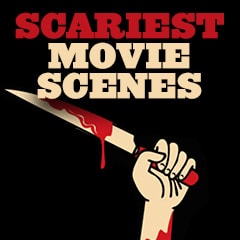
|
Greatest Scariest C-2 |
| Movie Title/Year and Brief Scene Description | |||||||||||||||||||||||||||||||||

|
The Changeling (1980, Canada) #54 In director Peter Medak's often over-looked, supernatural haunted-house cult classic, there were many tense, very effective, creepy, atmospheric, unsettling and scary sequences, without obvious jump-scares. Its slow-burn, deliberately-told and restrained story (with a melancholy tone) was about a vengeful young boy's ghost who sought retribution after being drowned by his own scheming father and replaced with a "changeling" or imposter. The elder 'changeling' was aware of the truth of what had happened in the past, and tried to ignore evidence (through a conspiracy of lies and cover-up) that the dead boy was seeking help to rectify the situation. In the plot, emotionally-devastated composer/musician and university teacher John Russell (George C. Scott) was a recently-mourning widower who was still having nightmares and privately dealing with his own personal tragedy. He had witnessed the death of his wife Joanna and young daughter Kathy in a freak snow-truck crash-accident in the film's opening during a winter vacation in upstate NY. He watched helplessly from a nearby phone booth as they were killed. He moved cross-country to find reflection in life and to teach at his alma mater in Seattle, where he rented and moved into a 3-story cavernous but elegant mansion. The home's lease deal was facilitated by one of the Historical Society's workers Claire Norman (Trish Van Devere), although he was warned by its representative Minnie Huxley (Ruth Springford) about the haunted Victorian-styled gothic house that had been vacant for 12 years:
Russell took the cautionary warnings as a sign that something else was going on: "She said the house didn't want people. She's mistaken. Whatever it is - is trying desperately to communicate." Deeply-disturbing imagery and supernatural phenomena (a piano key pressed by an unknown presence) and sounds were all the manifestations of the temper-tantrums of a young murdered boy's ghost-apparition's attempting to communicate. He also saw an apparition of the dead child under the water in a bathtub. Strange thunderous, echoing thumping noises represented the boy's fist banging on the side of a bathtub during a horrific drowning-murder. The presence of the boy was also indicated by running water faucets, doors slamming, and whispers that began to appear regularly to Russell, urging him to look deeper into the reasons for the disturbances. One early sequence was particularly unnerving and frightening. In the house, Russell was startled when his deceased daughter's red and white rubber ball bounced down the long wooden staircase. Russell picked it up and drove it to a bridge and dropped it into the water. Upon his return home at the foot of the stairway, the ball again bounced down the stairs to his feet. He appeared to feel helpless, unnerved and at the mercy of a violently-perturbed supernatural entity.
Russell also experienced a shattered reddish glass window pane while outside. In the upstairs of the spooky house, he uncovered a boarded-up storage closet leading to a hidden attic bedroom. In a disabled child's apparent bedroom (with a wheelchair and music box covered in dust and cobwebs), a music box played the same tune he had just recorded on the piano downstairs. During a seance in the house, the ghost also seemed to manifest itself through the frenzied medium Leah Harmon (Helen Burns) in a trance who repeatedly scribbed the word: "HELP" on a piece of paper. A long cone-shaped glass object suddenly flew off a table and smashed during the seance when the tormented spirit conveyed a message to the medium after being asked the question: "Joseph, did you die in this house?" After the seance, Russell replayed a reel-to-reel tape recording of the seance and was shocked to hear Joseph's voice on the tape - with significant clues: "Father. Father. The well. Ranch. Sacred Heart. My Medal. Father. Father. Don't! Help." Russell engaged in an investigation at the local library into the home's history with Claire. Searching through microfilm, they looked into a powerful local family that was linked to the house - the Carmichaels. The two suspected that the sounds and strange occurrences in the house were manifestations of a poltergeist - a crippled six year-old young boy named Joseph Carmichael, who had been murdered (drowned) by his father Richard Carmichael in the dusty attic's bathtub, many years earlier in 1906. The doorway to the attic was hidden and concealed behind a storage closet's bookcase. The film's main mystery element involved the present-day heir of the Carmichael family - the six term, powerful, wealthy and elderly, long-time Washington State's US Senator Joseph "Joe" Carmichael (Melvyn Douglas), the local symphony's benefactor. He was somehow involved in the child's murder, but wanted to conceal what had happened in the past. The motivation for the child's drowning was to preserve the family fortune (passed down from the boy's late maternal grandfather) that would have to be given over to charity (and not to the descendants of the Carmichael family) if the boy died before his 21st birthday. Worried that the young Joseph would die soon, his father Richard Carmichael drowned his son in a bathtub. He then secretly chose a "changeling" imposter or substitute - a healthy orphaned boy who assumed the name "Joseph" Carmichael to take his place. Years later, the 18 year-old stand-in youth - now supposedly 'cured' of his physical ailments during treatment in Europe, was returned to the US to inherit the Carmichael fortune. Russell's search for answers led him to a local property (owned by a Mrs. Grey (Frances Hyland) living with her daughter) that was previously owned by the Carmichaels. The young girl Linda (Janne Mortil) reported nightmares of seeing an emaciated ghostly boy staring at her and coming up through the floorboards of her house. Young Joseph's skeletal remains were found in a well as well as his baptism-birth medal. Russell attempted to confront Senator Carmichael about the medal, but was restrained from speaking with him. To retrieve Russell's medal, the Senator ordered Captain DeWitt (John Colicos) to Russell's home to demand the medal back: ("It's a little gold medal, a family heirloom, he lost it. He thinks you've got it"), but after being insulted by insinuations that he was disturbed by the recent deaths in his family, Russell refused to turn it over. The death of the Captain in a vehicular accident after he left the house was foreshadowed by the shattering of a mirror. Claire reported the unexplainable crash on the phone to Russell:
Finally, Russell confronted the aging Carmichael in the Senator's home with the entire story about the murdered son, his selection as an imposter-changeling ("That changeling was you") and how the murder of the young Joseph Carmichael had ultimately benefited him, but the Senator denied the truth of it. Russell was offered blackmail money to keep silent ("All right, how much do you want for this farce that you've concocted?") but he refused. Russell vehemently chastised the Senator:
The Senator berated Russell for accusing his father (actually step-father) of murder: "My father was not a murderer...My father was a great man, a loving man...I will not allow you to slander his good name." Before leaving and apologizing, Russell gave the Senator Joseph's real birth medal (found in the digging), his files and the seance recording. When Claire entered Russell's haunted house, she was terrified when pursued by young Joseph's cobweb-covered wheelchair from the attic and down the stairs. Russell arrived to save Claire from Joseph's ghost, but the ghost set the house on fire. Meanwhile in the Senator's home, he placed the real birth-baptism medallion on a portrait of his foster father Richard on his desk. He heard the doomed boy crying: "My medal" - and then "Father, don't!" before it began to violently shake.
The Senator became hypnotized and had an out-of-body or dream-like experience - his illusionary double entered the burning mansion, climbed the flaming stairs (Russell watched him) just before they collapsed, as he proceeded to the attic. A swinging chandelier in the foyer above Russell's head dropped and barely missed striking Russell on the floor.
In the attic, the Senator saw the same vision of Joseph's drowning death at the hands of his father. Then, back at his own home, the Senator suffered a fatal heart attack as the attic room exploded. He was wheeled into an ambulance from his home. At the same time, Claire had rescued Russell from the mansion that was burning to the ground. The next morning, the camera zoomed toward the burning embers of the ruined mansion, and focused on Joseph's burned-up wheelchair, and his music box that suddenly clicked open and began playing a lullaby. Justice seemed to have finally been attained. |
 Upstate NY Car Crash - Killing Russell's Wife Joanna and Daughter Kathy  John Russell (George C. Scott) Teaching Music at Seattle University 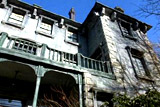 John Russell's Rented 3-Story Gothic Mansion in Seattle  Apparition of Young Boy (Joseph Carmichael) Drowning Underwater  Seance - Crashing of Glassy Cone-Shaped Object  Russell in Library Researching the Home's History With Claire  Flashback: The Drowning of Young 6-Year Old Joseph Carmichael by His Father Richard  Death of Captain DeWitt in Car Crash Foreshadowed by Shattered Mirror in House  Claire Pursued by Joseph's Cob-Web Covered Wheelchair From the Attic  US Senator Joseph "Joe" Carmichael (Melvyn Douglas) Revealed as "The Changeling" - Holding Up the Two Baptism-Birth Medallions (Fake and Real) to Compare Them  Senator Carmichael's Fatal Heart Attack in His Home |
|||||||||||||||||||||||||||||||

|
Un Chien Andalou (1929, Fr.) (aka An Andalusian Dog) (short) Spanish director Luis Bunuel's short silent film (written in collaboration with artist Salvador Dali) with a non-sensical title (it literally meant "An Andalusian Dog") was a surrealistic adventure to behold. Filmed low-budget, the dreamy film took only two weeks to shoot. It began with the ominous title card, "Once upon a time." In the shocking and disturbing opening sequence, composed of freely associated images, a man sharpened a straight razor and then tested the sharp blade on his fingernail. On a balcony, he viewed the full moon, where a cloud was about to pass over it and bisect it. He then moved the sharp-edged blade close to a woman's (Simone Mareuil) wide-opened eye and sliced it in half, as the cloud sliced into the moon. -- (it was actually a cow's eye that was being cut).
Later in the film, there were other striking images presented in an unlinked series, including that of ants coming out of a hole in a man's severed hand, a severed hand lying on a street sidewalk, the grabbing of the breasts of a woman through her clothes (and then of her naked breasts directly when the clothes disappeared) - and the man's fantasizing that the breasts were her bare buttocks, a grand piano with a dead donkey on top of it, and the final image of a couple half-buried on a beach in sand up to their elbows (and probably dead). |
  
Straight-Razor Eye-Slicing |
|||||||||||||||||||||||||||||||

|
Children of the Corn (1984) #10 In this 1977 Stephen King short story tale that was adapted for the screen, children in the isolated and deserted farmland (fictional) town of Gatlin, Nebraska were slaughtering all of the adult townspeople in the name of a demonic God dubbed "He Who Walks Behind the Rows" - in order to produce a prosperous corn harvest. The creepy story was told by a young boy in the town, a narrator named Job (Robby Kiger). It played on the fears of disobedient, out-of-control, monstrous children preying on all adults and running their own society. The film opened with the coffee shop massacre of Gatlin adults after Sunday worship services in the local Baptist church. Some of the patrons were poisoned by the coffee, and others were hacked by a meat-cleaver.
The massacre was depicted in crayon drawings (under the opening credits) created by Job's sister Sarah (Anne Marie McEvoy). The sketches often foreshadowed what would happen next. The young fanatical cultish murderers were led by boy preacher Isaac Chroner (John Franklin) with an Amish-styled hat, who glared through the front window of the coffee shop before the slaughter. Isaac's followers fashioned corn-cob crucifixes (one held a dead cop) and held sinister religious meetings and rituals in the corn fields, often at dusk. No one 19 years or older was allowed to live. Isaac often preached about the bloodthirsty incarnation of the Abrahamic God, dubbed "He Who Walks Behind The Rows." Two cross-country travelers passing through the town on their way to Seattle: Vicky Baxter (Linda Hamilton) and her boyfriend Burton Stanton (Peter Horton), accidentally struck a runaway Gatlin boy named Joseph (Jonas Marlowe) in the middle of the road. He had tried to escape from Gatlin and had stumbled out onto the highway clutching his sliced throat - and it appeared that his throat was slit before being killed by the impact. When Vicky dozed off, she dreamed that the boy awoke and reached out to strangle her from under a blanket - the film's scary jump-boo moment. Sadistic and menacing, red-headed Malachai Boardman (Courtney Gains), Isaac's curved blade-wielding enforcer for the cult of murderous children, led a group of children who abducted Vicky. She was tied to a giant corn-dressed cross or crucifix and hoisted up, while the children chanted "Kill" - demanding her sacrifice. Wounded in the chest and attempting to escape a group of crazed children, Burt was surrounded in the middle of the street, as Malachai called out tauntingly: "Outlander!" When Malachai mutinied against Isaac, he ordered Isaac to be crucified in Vicky's place. Shortly later, Malachai took a bound Vicky at knife-point into the deserted street and tried to lure Burt out of hiding, shouting: "Outlander! Outlander! We have your woman. She still lives! Outlander, maybe you don't hear so well" - and then sliced into her cheek with his machete, drawing blood - "Outlander! Her blood'll spill unless you give yourself up." When Malachai turned on Isaac, he ordered Vicky cut down from the cross and Isaac put up in her place. Hanging on the crucifix, Isaac was seemingly devoured and consumed by "He Who Walks Behind the Rows," a reddish protoplasmic form that crept up his body, after which his cross sky-rocketed into the air. Isaac was then transformed into a reanimated zombie-like follower of the demonic god, speaking in a deep voice. When Isaac was sent back, he cried out: "Malachai! He wants you too, Malachai. He wants you too!" He strangled and broke the neck of Malachai. The beastly god then took the form of a giant, bloody-red cloud of "fire and brimstone" - grimacing as it was destroyed when the cornfields were burned to the ground. One final boo moment occurred as a female cult member in the back seat of Burt's car popped up with a curved blade, but the threat was quickly subdued. |
   Death of Joseph  Dead Cop on Cross   "Outlander! Her blood'll spill..."   Isaac on Cross  Final Boo Moment |
|||||||||||||||||||||||||||||||

|
Child's Play (1988) #94 Child's Play (1988) was the first in a series of Chucky supernatural horror films (1988, 1990, 1991, 1998, and 2004), about a plastic killer doll named "Chucky." In the film's prologue, a Good Guy doll in a Chicago toy store was imbued (through a Haitian voodoo ritual) with the evil soul of lethally-wounded serial killer Charles Lee Ray (Brad Dourif), known as "The Lakeshore Strangler." Widowed mother Karen Barclay (Catherine Hicks) bought the blue-eyed, cherub-faced, red-haired, freckled toy doll - a cheaper-priced, $30 stolen Good Guy doll from a homeless street vendor, to give to her son Andy (Alex Vincent) as a 6th birthday present. The vicious Chucky, looking innocent with blue overalls and sneakers, committed his first murder, the killing of young Andy's babysitting Aunt Maggie Peterson (Dinah Manoff). He emerged from Andy's bedroom (shot from Chucky's POV), and deftly stalked her, causing her to have an 'attack' of the "alone-at-night-willies." She admitted to herself: "What is wrong with me? I'm scaring myself half to death." When she turned, he suddenly struck her in the right eye with a hammer, and she was propelled backwards - she fell out of the multi-storied apartment's kitchen window to her death, crashing into the top of a parked truck on the street. Later, in one of the film's scariest moments, Chucky was talking and moving (he told Karen: "Hi, I like to be hugged"), but without the included batteries installed. She held the doll in her hands and inspected the battery compartment, and to her shock found it empty. The doll's head suddenly twisted around and spoke: "Hi, I'm Chucky! Wanna play?"
In fright and suspecting that the doll was murderous, she dropped the doll and it rolled out of view under the sofa. When she peered underneath the sofa and poked at it, the doll appeared to be lifeless. When she threatened to throw it in the fireplace when it didn't move or talk back to her, the doll suddenly shouted curses at Karen: "You stupid bitch! You filthy slut! I'll teach you to f--k with me," and began struggling with her, leaving deep bite marks in her arm. Afterwards, Chucky descended to the ground floor in the apartment's elevator and disappeared. Chucky's subsequent murders were blamed on prime suspect, Andy, who was hospitalized for psychiatric evaluation. Chucky's main intent was to transfer his soul into Andy's body. In the exciting climax in the apartment, to help save his mother, Andy struck a match and threatened to burn the doll alive in the fireplace. Although Chucky begged, "Andy, no, please! We're friends to the end, remember?", Andy snarled: "This is the end, friend!"
Still alive although charred, Chucky screamed out: "Give me the boy!" as he pursued Andy and Karen with a knife. In the hallway, Karen shot off Chucky's body parts (head, right arm, and left leg), but Chucky's severed head suddenly came alive and ordered the other body parts to attack ("Choke him! Kill him!...Kill them! Kill them all!"). Finally, Chucky was shot in his vulnerable heart by detective Mike Norris (Chris Sarandon), and he died repeating his favorite phrase: "Hi, I'm Chucky. Wanna plaaaaay!" |
 Serial Killer Charles Lee Ray Imbuing Doll With Killer Abilities  Chucky with Andy  Death of Aunt Maggie Peterson  Chucky Pursuing Karen with Knife   Chucky's Severed Head |
|||||||||||||||||||||||||||||||

|
Director Roman Polanski's neo-noir thriller, with a taut and complex script by Robert Towne, was a skillful blend of mystery, romance, suspense, and hard boiled detective/film noir genre elements. The investigation of a routine story by a detective uncovered secrets under many layers, facades, red herrings, and networks of corruption, conspiracy and deception. His efforts to separate good from evil - to save the good and punish the evil - ultimately failed in the metaphoric (and then real) world of Chinatown by the film's climax. In a tense nose-cutting scene, snooping LA private detective J.J. "Jake" Gittes (Jack Nicholson) was threatened to stay off the case by a maniacal, intimidating, knife-wielding hoodlum (director Roman Polanski in a cameo role):
In the film's tragic ending, occurring in Chinatown itself, Evelyn Cross Mulwray (Faye Dunaway) was shot through the head from behind in her fleeing convertible. Jake, the first to get to the car, opened the driver's door and she flopped toward him - her face was horribly blown apart through her flawed eye. She had literally been destroyed by her domineering water-tycoon father Noah Cross (John Huston), who lamented: "Lord, Oh Lord," as he clumsily shielded and covered the eyes of an hysterical daughter/grand-daughter Katherine (Belinda Palmer) - a child born of incest! He told her: "Don't look, don't look" - to prevent her from comprehending the enormous tragedy. The tragic ending included the haunting closing line told to Jake: "Forget it, Jake, it's Chinatown." |
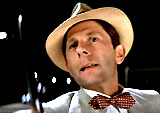  Hoodlum Threatening Jake Gittes  Evelyn Shot to Death  Noah Cross with Daughter of Incest Katherine 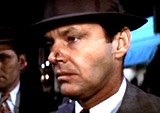 "Forget it, Jake, it's Chinatown" |
|||||||||||||||||||||||||||||||

|
Christine (1983) #17 An evil-possessed red and white 1958 Plymouth Fury, an inanimate object that took on a life of its own, was the basis for John Carpenter's horror film, based upon Stephen King's book of the same name. The sentient vehicle became obsessively-jealous of introverted nerd owner Arnie Cunningham's (Keith Gordon) new girlfriend Leigh Cabot (Alexandra Paul). At a drive-in theatre on a rainy night, the malevolent car threatened Leigh and she nearly died. Christine caused a number of threatening incidents to frighten both Leigh and Arnie:
Afterwards, Leigh delivered an ultimatum to her car-fixated boyfriend. In other scary scenes, the evil, flaming Christine chased Buddy Reperton (William Ostrander), one of Arnie's enemies who had severely vandalized Christine. Seeking revenge, the malevolent Christine (now able to regenerate herself) ran down Buddy as he fled on the highway - and left him a flaming corpse on the road. Christine similarly stalked Peter "Moochie" Welch
(Malcolm Danare), a member of Buddy's gang, down into a narrow
alleyway and pinned him against a wall - crushing him to death. Arnie grasped onto Leigh, and then fell back, with a sharp shard of glass in his ribs. He reached out his bloody hand (after removing the shard) and caressed Christine's front grille, before expiring (as Christine's headlights extinguished in respect). |
 Leigh Choking on Popcorn  The Death of Buddy  The Death of "Moochie"    Arnie's Death |
|||||||||||||||||||||||||||||||

|
Cliffhanger (1993) In the opening tense scene of director Renny Harlin's action film, an operational rescue on a steep towering 4,000 foot mountain peak in the Rocky Mountains was being attempted. Hot-shot rescue worker Gabe Walker (Sylvester Stallone) climbed up to where the two stranded climbers were perched on a narrow ledge:
With assistance from a rescue helicopter, after Hal was rescued by harnessing himself to a steel cable stretched over a chasm, it was now nervous Sarah's turn (Walker called it "the best ride in the park"). She was assured: "There's nothing to it." But she found herself dangling over the deep chasm when her harness broke. Walker made the risky decision to go out on the line and daringly rescue her. She reached up with her right hand to grab Walker's hand - and was suspended in mid-air by one hand, while screaming out:
But she found herself slipping and losing her grip, and when her glove came off in Walker's hand, she fell to her death in the abyss below. |
  
The Death of Sarah |
|||||||||||||||||||||||||||||||

|
#2 This controversial film was producer-director-screenwriter Stanley Kubrick's randomly ultra-violent, over-indulgent, graphically-stylized film of the near future. It followed the delinquent activities of young punker Alex de Large (Malcolm McDowell), with a group of his Droogs (Pete, Georgie and Dim), during one night on the town. After beating up an elderly drunken tramp (Paul Farrell), they fought off a rival gang of five, led by Billyboy (Richard Connaught), that was in the midst of raping a buxom victim or 'devotchka' (Shirley Jaffe) on an empty opera house stage.
Then they came upon an ultra-modern house where they deceptively gained entry. Next came the abhorrent scene of the assault and rape of the couple in the house. Both victims were bound and gagged, with a rubber ball painfully inserted into their mouths and wrapped with long strips of Scotch tape around their heads. The red pajama-suit-wearing writer's wife Mrs. Alexander (Adrienne Corri) was raped, while the elderly husband Frank Alexander (Patrick Magee) was assaulted and kicked on the floor by Alex who ironically punctuated his rhythmic, soft-shoe kick-dance with the lyrics of "Singin' in the Rain." He was forced to helplessly watch the ugly disrobing and choreographed rape of his own wife when Alex first attacked her breasts - he snipped off two circles of jumpsuit cloth around them to expose them and then in the mode of 'Jack the Ripper', he slit her entire suit off from her pant leg upward; after unzipping and pulling his own pants down prior to her rape, he mocked the husband: "Viddy well, little brother. Viddy well." One of the more controversial scenes was of a gigantic penis sculpture being used as a murder weapon by a gang of juvenile delinquent droogs on a female victim. A wiry, introverted red-haired Englishwoman Miss Weathers, known as the 'Cat Lady' (Miriam Karlin) was in an almost-deserted, isolated Woodmere Health Farm outside of town. She was exercising on the floor surrounded by dozens of cats when she heard knocking, but refused to answer. Alex sneakily entered through a window on the second floor, and confronted her while grinning: "Hi-hi-hi-hi there!" He called her giant phallus artifact "naughty, naughty, naughty. You filthy old soomka." When he rocked her giant, obscene phallus sculpture on its testicles, she screamed: "Leave that alone! Don't touch it! It's a very important work of art." The Catlady retaliated by picking up a bust of his beloved Beethoven and rushed at him - they dueled each other with antagonistic weapons. He held her off with the oversized phallus, while she thrust the small bust of Beethoven at him. When she went down on the floor, Alex raised the Beethoven sculpture above her and plunged it down into her - filmed from a low angle. As she screamed, a close-up of a mouth within another open mouth (from one of the pop paintings in the rooms) flashed on-screen with other dismembered body parts in an orgy of modern art. Alex left her senseless and beaten on the floor, mortally wounded by her own sculpture-turned-weapon, when he heard sounds of distant police sirens. There were also the scenes of Alex being given a new, experimental, brain-washing reprogramming treatment called "aversion therapy," the Ludovico Treatment Technique, to cure him. He was strait-jacketed and transported to a screening room where he was tied down in a seat and made a captive audience. He was forced to watch films (of sex and violence) with his eyelids clamped open with pitiless clamps, while an assistant lubricated his bulging pupils at various intervals. His tortured face and head were wrapped in straps, and connected with electrodes and wires. He was also subjected to experiments to suppress his violent and aggressive sexual drives and urges (including being tempted by a topless woman). In the process of behavior modification, he had given up his own individual and personal rights in order to become a model citizen. Frail and crushed by despotic training and brainwashing, Alex became a victim of violence himself, totally unprepared and helpless to cope with the real world when he was returned to society. The revenge-seeking former victims included:
Although Alex was rescued by two policemen, the two were Georgie and Dim, two of his former Droogs. Alex was roughly dragged to their patrol car and driven into the country. As he was led out of the vehicle with handcuffs, Alex feebly joked: "The old days are dead and gone. For what I did in the past, I've been punished...I've been cured." As they lead him down a forested, muddy lane, in a long tracking shot filmed with a hand-held camera from behind, accompanied by a Moog synthesizer playing "Music for the Funeral of Queen Mary," Dim wanted to make sure that he remained cured: "This is to make sure you stay cured." When they reached a water trough, Georgie viciously hit Alex in the stomach with his blackjack club, doubling him over. For retribution, Dim pushed him headfirst under the water and held him there for a very long time to drown him, while Georgie methodically beat him with his nightstick. In the nihilistic ending adapted from the Anthony Burgess novel (without including the last chapter in the film adaptation), it was learned that juvenile droog Alex, 'cured' of being an ultra-violent youth in futuristic England, had attempted suicide after his cruel behavioral conditioning, and was hospitalized. The Minister of the Interior (Anthony Sharp) explained to bed-bound Alex, as he was spoon-fed, how he had authorized the undoing of the effects of the Ludovico Technique and was attempting to restore Alex to his previous condition (with the freedom of choice and therefore the right to take pleasure in violence). He promised to help restore Alex with a good job and salary, in exchange for Alex publicly absolving the government for its inhumane Ludovico Technique experiments. The Minister effectively seduced Alex over to the government's side: It was apparent that Alex had learned nothing from his behavioral modification treatments by the state. He was returned to his former self - with his free will intact and with his old proclivities for sex and violence. After giving a thumbs-up signal to the press and mugging for the cameras, Alex's eyes glazed and rolled back (in a semi-Kubrick stare with facial contortions), and he found peace as he fantasized a pseudo-orgy while trapped in his hospital bed. He saw himself copulating (making love to/or raping?) with a beautiful blonde woman who wore only black silk stockings - they were frolicking naked in slow-motion on piles of white snow, while two rows of genteel-looking, Victorian Londoners (ladies and gentlemen), the men dressed in top hats and the women carrying parasols, looked on and sedately applauded toward them. Alex had reverted to his old, pre-conditioned behavior, as he triumphantly and sardonically said, in voice-over:
|
  The First Controversial Rape Scene of a 'Devotchka' (Shirley Jaffe)    Alex With Penis Sculpture Raised Above Head - Used as Murder Weapon on Cat Lady   The Ludovico Treatment   Sexual Temptations  Alex's Near-Drowning  The Minister of the Interior Spoon-Feeding Alex  Alex's Eyes Rolling Back   "I Was Cured All Right" |
|||||||||||||||||||||||||||||||
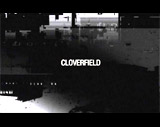
|
Cloverfield (2008) #12 Director Matt Reeves' 'found-footage' action horror-thriller (his first feature film), an American monster and disaster movie, was produced by J.J. Abrams (responsible for popular TV shows including Alias, Lost, Fringe, and Person of Interest), so it was only natural that it was hyped and advertised with a viral media campaign with lots of obscuring secrecy (with a '1-18-08' trailer). Many compared the film's events to the horrors experienced by New Yorkers during 9/11. The short 84-minute film's tagline was: "SOME THING HAS FOUND US." Critics lambasted the Godzilla-like, alien-attack film (similar to the pre 9/11 American remake of Godzilla (1998)) for its derivative nature, poor acting and script-writing. The jerky, documentary-styled, You-Tube, cinema-verite filming was similar to George A. Romero's Diary of the Dead (2007), Paranormal Activity (2007), Redacted (2007) and many other such 'found-footage' films, such as the influential The Blair Witch Project (1999). Some theaters advertised that the hand-held film method would cause symptoms of motion-sickness ("similar to riding a rollercoaster") that might produce nausea and vomiting. When the disaster film started with a color bars test pattern, it was presented as chilling and oblique video footage recovered by the US Department of Defense - the personal recording was located in an area known as US447 ("formerly known as Central Park"). Most of the video was filmed on the night of Friday, May 22, 2009 (and the next early morning). Its two main characters (in a cast of unknowns) were a young couple introduced in a mid-town Manhattan apartment, the female's dad's place (who was out of town):
They were planning a Coney Island date in late April - but then the events tape-recorded shifted to three weeks later - in late May, when the horrors began. Other vacuous, 20-something characters included:
There were many catastrophes in this film, most of which were caused by the appearance (slowly revealed) of a monstrous scaly creature with fireballs for breath (covered with superfast, vicious spider or crab-like parasites that fell off and attacked), who threatened the entire city - and in particular, the above group of friends:
An ill-advised up-town odyssey was made by friends (Rob, Hud, Lily, and Marlena) to rescue Beth, who was trapped in her mid-town apartment (on the 39th floor), while mass mandatory evacuations were taking place just before the military planned to destroy Manhattan ("Hammer Down Protocol"). The rescue operation was code-named Cloverfield. One of the scariest sequences was filmed in the pitch-black darkness of the Spring Street subway station, where the small group was attacked by one of the crab-like creatures, and Marlena suffered a lethal toxic bite on her shoulder, and later complained: "I don't feel so good" before dying.
The helicopter carrying an injured Beth, Rob, and Hud crashed in Central Park after being attacked by the Monster, wounding Hud before he was literally consumed by the beast. In the film's final moments, Beth and Rob awaited the destruction of the city. They each gave a self-filmed testimonial, beginning with Rob:
Then, they professed their love for each other as a massive bomb hit, monstrous roars were heard, and rubble fell onto them: (Rob: "Look at me! Look at me! I love you!" Beth: "I love you!" Part of the film's appeal was that Hud had been taping over happier footage of Rob and Beth a few weeks earlier (on their Coney Island date on April 27th at 6:17 PM), shown as the film ended.
|
 Taking Flight  Brief Glimpse of Monster  Evacuation by Helicopter   Aerial View of Monster Being Bombed  Hud's View of Monster Before Being Eaten  "My name is Robert Hawkins..."  "My name is Elizabeth McIntyre..."  Concluding Bombing  Coney Island footage: "I had a good day" |
|||||||||||||||||||||||||||||||
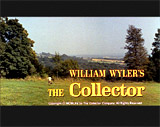
|
The Collector (1965, UK) (aka The Butterfly Collector) Director William Wyler shot this claustrophobic yet absorbing psychological thriller - based upon John Fowles' 1963 novel of the same name. It was basically a one-situation, two-character work, told from the POV of a kidnapper. Its tagline stated:
The main character, identified by his amateur hobby-occupation (lepidoptery), was a reclusive individual who was obsessed with butterfly collecting. Freddie Clegg (Terence Stamp) was a mentally-disturbed, shy, introverted, obsessed young London bank clerk. In a flashback, it was shown that his Aunt Annie (Mona Washbourne) informed him that he had won a football betting pool with a prize of $200,000 (71,000 pounds). With the money, he bought and renovated a huge rural Tudor country estate in Sussex. For a long time, he had been stalking and spying upon a pretty London art student on a scholarship at the Blake School of Art - to make her part of his 'butterfly' collection in his home's ornate underground cellar. He at first thought that he couldn't carry through with his plan:
Finally, he acquired the courage to chloroform and make her captive as a female hostage (or "specimen"):
He cornered her in a narrow alleyway, placed a chloroformed cloth over her mouth until she passed out, then gagged and bound her hands before driving her in his black van back to his manor home. She was imprisoned in the manor's underground, stone-lined basement adjoined to the main house but with a separate entrance. It was a padlocked lower room hidden by a fake wall with a bookcase. During his first visit with her, when he brought her food on a tray, she demanded release: "I demand to be released at once," but he refused. He bragged: "I know a lot about you, more than you think." He had been attentive to her and had studied her over a long time, knowing her father's name and her clothes' basic sizes, plus he had supplied her 'prison' with art books. He was pleased with himself in town when he saw a newspaper article about a "BEAUTIFUL ART STUDENT MISSING." During a second visit with her, she asked defiantly: "I'm your prisoner, but you want me to be a happy prisoner. Why?" Not intent on sex, rape, molestation, ransom or murder, he said that his main (pathological motive) was to make her his "guest" - to "collect" and dominate her and add her to his set of pretty objects - and hoping that she would eventually reciprocate his feelings of love. He grabbed her - but with the sensation of physical contact, it incited him to whisper into her ear: "I love you" - a shocking revelation. He basically replied that he would respect her and only become acquainted: "Funny thing is - I told myself a dozen times, I wasn't going to tell you. I was going to let it come natural on both sides. But I touched you just then, it came out....I want you to get to know me." She tried to reason with him ("But you don't kidnap people so they'll get to know you. Don't you realize the trouble that you could get into?"), and told him that if she was released, she wouldn't tell anyone.
Although she gave the pretense of being cooperative, her many attempts and ploys to escape were unsuccessful. Once, she thought she could escape through a second locked door, but he had anticipated her flight and stopped her. She dared to slap him, causing him to be open to negotiating for her release. He implied that the length of her stay depended upon how soon she would get to truly know him and love him back - at least a minimum of a month more. He seemed to finally agree that he would release her in 4 weeks. She couldn't get him to listen to her distaste for him: "Don't you see that four months, four years, won't get what you want?" But in the meantime, she bargained for concessions: a letter to her parents, fresh air and light, a bath, some drawing materials, medications, and fresh fruit and salad. After about a week went by, he allowed her out of the dungeon for fresh air and the promise of a bath. With her hands bound, he creepily and lovingly touched her hair - causing her to instinctively and defensively yell for help before he covered her mouth. She forced him to promise to never again touch her in the same way, but if he did, she made a bold request and ultimatum that he not abuse her:
In one of the more tense scenes in the film between captor and captive, Freddie allowed Miranda to take a bath on the second floor of the main house, and vowed that he would respect her privacy, although he would guard the unlockable door from the outside. She was almost discovered by an unexpected visit at the front door from neighbor Colonel Whitcomb (Maurice Dallimore). Freddie gagged her to prevent screaming, wrapped a robe around her, and lashed her to the pipes. Then, Freddie went downstairs where the neighbor greeted him as "Franklin," and complained that electrical modifications he had made to the basement would upset "the Ancient Monuments people" - who regarded it as an historical edifice that needed to be preserved. She tried to alert the neighbor before he departed by using her outstretched foot to turn on the water flow into the tub - to create the sound of running water. The neighbor did ask about it, but Freddie covered up by claiming his male cousin was visiting. However, when water in the tub began to overlow out of the tub and down the stairs - it was noticed by both of them. Freddie ran upstairs to deal with the situation (and to tie up Miranda more tightly), while again lying that it was really his girlfriend who was visiting - and that she had a reason to not call out to alert him about the faulty water faucet: "She was embarrassed. You know how it is."
After the incident with the tub before she was imprisoned again, Miranda requested that her bindings be tied in the front to avoid pain. Freddie proudly showed her his hobby's collection of butterflies (some raised from larvae, while some other aberrations were bred by him) - while she made the obvious connection between his beautiful insect collection (of dead specimens) and her own entrapment as his latest collectible item that he had become infatuated with - the image of her face was reflected on the glass, implying that she was also caught and pinned for his enjoyment:
She recognized that he was the recent winner of a fortune - and that he had many opportunities available to him - other than death: "You could do so much. You could travel, learn, meet people. You could have a wonderful life. But this is death, don't you see? Nothing but death. These are dead. I'm dead. Everything here is dead. Is that what you love - death?" Many days later, she was allowed to write a dictated letter to her parents, as he had earlier promised, but then she was caught attempting to put a second note of distress in the envelope: ("Kidnapped by madman. Gerald Franklin. Pools winner. Prisoner in cellar, old Tudor house, near Reading. So far safe. Frightened."). After an argument, he stated how she still detested him: ("I'm a nobody still, aren't I?") - along with her friends and people of her type: ("Your friends would look down on me like you do...I've seen you with your friends. I know what they're like. You'd be ashamed of me in front of them"). As he departed, he ripped up the notes. On the day that she was supposedly to receive her "freedom" (June 11th) with release at midnight, they discussed their different views of Holden Caufield in J.D. Salinger's "The Catcher in the Rye" and a Picasso painting. Freddie accused her of being patronizing and condescending: ("Don't patronize me...You see, you won't really talk to me"). He feared that he would be seen as ignorant and that he would be incompatible in the real world with people who held opinions like her and her friends:
Fearing that she had lost her chance at freedom, Miranda was slightly encouraged when he presented her with a gift - an evening dress in a box, to be worn that evening during a private dinner with him. At a candlelit table complete with champagne and caviar, he gave her a ring box - and proposed marriage (in name only). There would be certain conditions - she could live in the house in her own lockable bedroom if she wanted. Although she replied it couldn't be considered a real marriage ("I couldn't marry a man I don't belong to - in every way"), to comply, she agreed to marry him, but then he immediately expressed reservations - marriage would require outside witnesses ("Don't you think I know you need witnesses to get married?"), and asserted with a sinister stare that he could change his mind: ("I can do what I like!").
When she tried to escape from him and fled to his butterfly room, he chloroformed her and carried her to his upstairs bedroom, where he placed her on the bed and caressed and embraced her body and face. The next day in the basement, Freddie asserted that he hadn't taken advantage of her when she was unconscious, and since she hadn't fallen in love with him yet, he had no choice but to keep her longer. Later inside the main house, Miranda expressed how she wanted them to be friends again: ("I'd like us to try and be friends again"). She sat on his lap and requested a kiss - and then after her hands were untied, she slowly let her hair down and undressed and let her nightgown fall to the ground: ("Would I be doing this if I were only pretending?"). He laid on top of her and began to kiss her, but then pulled back and accused her of pretending and manipulating him to let her go: "You think if I make love to you I'll have to let you go." And then he threw her clothes back at her, ordered her to dress, and shouted out that he no longer respected her - he compared her to a whore:
He threw her sketched and framed self-portrait in the fireplace, and rebound her hands, as she suddenly realized: "I'm never getting out of here alive, am I?" As they approached the cellar on a cold and rainy night, she hit him in the head with a shovel and bloodied him before running off. But he was still conscious and able to chase and grab her, drag her back and imprison her again. As he locked the door, she accidentally knocked over an electric heater and it shorted out. He went for medical attention to get treatment, unknowingly leaving her wet and cold in the cellar without heat. She worried that he would die and leave her imprisoned without any means of escape: "Please don't die!" In the chilling finale three days later, he returned and found her extremely ill - probably suffering from pneumonia. After she begged for help and collapsed, he realized she was seriously ill when she entreated: "I don't want to die." He rushed off again to get a doctor for her, leaving the doors wide open, but she lacked the strength to escape.
In town, he realized he couldn't contact a doctor, and instead bought some over-the-counter medicine from a local pharmacy. When he returned, he found that Miranda had already died. He recollected his time with her through a voice-over: "I sat there all the rest of the afternoon, remembering." After burying her in a homemade coffin, he concluded that he had failed with Miranda (and it was mostly her fault), because he had set his sights too high on a higher-class female:
He drove off to stalk after his next target - a nurse (Edina Roday) who had treated him in the hospital. |
 The 'Butterfly' Collector: Freddie Clegg (Terence Stamp)  Kidnapping of Miranda Grey (Samantha Eggar)  Unconscious 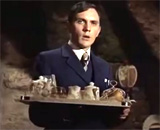  Bringing His Prisoner Food in the Stone-Lined Crypt    Freddie Touching Her Lovingly - Causing Her to Yell For Help 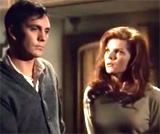 Miranda's Bold Ultimatum  Miranda Preparing for Bath in Upstairs of House  Arrival of Nosy Neighbor Colonel Whitcomb  Water Flowing Down the Stairs From 2nd Floor Tub  Freddie Turning Off the Tub Faucet in Bathroom   Freddie's Dead Butterfly Collection  Freddie Discovering Her "Frightened" Note For Help  "Freedom" Day - June 11th  Freddie Feeling Inferior During a Discussion of Picasso and 'The Catcher in the Rye'  Candlelit Dinner with Champagne 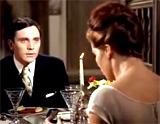 Proposal of Marriage   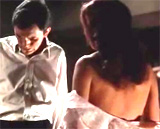 Kissing and Undressing In Front of Him  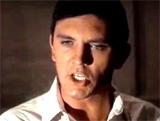 "You're No Better Than a Common Street Woman" 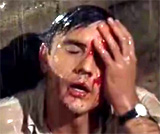 Clobbered in the Head With a Shovel  Freddie's New Target |
|||||||||||||||||||||||||||||||

|
Color of Night (1994) This psychological thriller by director Richard Rush introduced the character of distraught New York City psychoanalyst Dr. Bill Capa (big-name star Bruce Willis). Suffering from stress-induced, psychosomatic color blindness, he quit his practice and traveled to LA to stay with analyst/author friend Dr. Robert Moore (Scott Bakula). During a brief scene, Dr. Capa was jogging up to the Los Angeles area house where he had taken temporary residence after the death of his therapist friend. When he opened the mailbox, the jump scare was fantastic and unexpected - a huge rattlesnake had been planted there - it lunged at him. He was sent sprawling backwards onto the road, where he was almost run over by a motorist driving by. |
  
Jump Scare: Rattlesnake in Mailbox |
|||||||||||||||||||||||||||||||

|
Creature From the Black Lagoon (1954) This classic Universal horror film was by director Jack Arnold - originally shot in 3-D, and was the last great prototypical classic from Universal Studios. In the pantheon of Universal Monsters, only The Creature was given the 3D treatment. Special effects effectively used a foam-latex costume suit to represent the amphibious creature called the Gill-Man - one of the most famous movie monsters ever created. Director Guillermo del Toro years later used the movie as inspiration for his Best Picture-winning The Shape of Water (2017). The campy film began with the discovery in an upper Amazonian jungle of a fossilized claw or hand (with webbed fingers) embedded in rock by Dr. Carl Maia (Antonio Moren) - it was evidence of an unusual, prehistoric, amphibious web-handed and footed humanoid-reptile. The discovery might prove that a strong, prehistoric creature existed linked sea and land animals. Not visible to the scientist, a similar-looking webbed hand emerged from the river bank and then slid back into the water after leaving claw marks.
Slightly later, Dr. Maia's two assistants, Tomas (Perry Lopez) and Luis (Rodd Redwing) at their campsite were suddenly attacked by a humanoid creature (first seen as a disembodied claw reaching into their tent) - a descendant of the fossil species. Both men were grabbed by the claw in the face and killed amidst ferocious growls. It was presumed that a jaguar had attacked them with its claws. As the group surveyed the campsite, Kay stood by the water's edge as the clawed hand reached out for her legs, but was unable to grab her.
An anthropological expedition was organized by Dr. Maia and funded by Dr. Mark Williams (Richard Denning) to a Brazilian river in the Amazon on board the Rita. They were accompanied by ichthyologist Dr. David Reed (Richard Carlson) and his dark-haired girlfriend/fiancee and colleague Kay Lawrence (Julia Adams), and scientist Dr. Edwin Thompson (Whit Bissell). Others included Captain Lucas (Nestor Paiva) and two crew members Zee (Bernie Gozier) and Chico (Henry Escalante). It was eventually thought that more fossil remains or a descendant of the original fossilized creature, a Gill-Man (Ben Chapman), might be living in a dark lagoon known as the "Black Lagoon." Once the Rita arrived at the Black Lagoon, two of the expedition members, Reed and Williams went scuba diving to investigate and find some samples - unaware that they were being stalked by the Gill-Man. After the divers returned, Kay took an impromptu swim by herself - in a stunning one-piece white bathing suit. In scary and superbly-photographed underwater sequences, as she swam at the surface, the creature expressed 'Beauty-and-the-Beast' love interest in bathing beauty Kay, stalking and watching her from below as she swam above him. He even appeared to mirror or mimic her movements.
After Kay's swim, the Creature was briefly caught in one of the ship's draglines, and although it escaped, it left behind a claw in the net, proving its existence. Kay expressed dismay, realized that she had possibly been swimming near the Creature. The expedition's two divers, Reed and Williams pursued the Creature and were able to spear it underwater with a fishing gun, but it escaped.
After several deadly encounters with the Gill-Man and the death of two crew members Zee and Chico, the Creature was captured and caged up onboard the Rita. When it escaped, it attacked Dr. Thompson who hit the Creature with a lantern and set it on fire, but Dr. Thompson was seriously wounded. As the group decided to leave the lagoon, they realized that their exit-way was blocked. When Dr. Williams went underwater to capture the creature, he was mauled to death as Dr. Reed watched and eventually scared the Gill-Man off.
Soon after, the Creature reached in through a porthole to attack the bandaged and ailing Dr. Thompson, and Kay was grabbed and kidnapped from the boat. It dove into the water with her and took her back to its swampy cave or grotto hidden by the bank, but she was soon pursued by Dr. Reed who came to Kay's rescue. As the Creature was attacking Dr. Reed, it was shot with bullets (by Dr. Maia and the Captain) and severely injured in the chest with bullet wounds. Dr. Reed allowed the Creature to retreat back to the lagoon's beach where it swam off, disappeared, and sank lifelessly back into the deep watery depths of the lagoon.
|
 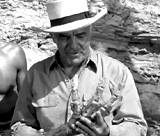 Discovery of Fossilized Claw in Rock  Claw That Emerged on River Bank - Similar to the Fossil  Picture of Fossil Discovery  Clawed Hand Reaching Out for Kay's Legs  Expedition into the Black Lagoon  Creature Underwater - Stalking the Divers  Kay Preparing to Swim in the Black Lagoon  Claw Found in Net  Kay Disturbed by the Finding   Creature Attacking Crew Member Chico on Deck of the Rita  Captured in Spotlight Emerging From Water |
|||||||||||||||||||||||||||||||

|
Creepshow (1982) #99 Creepshow was a horror anthology film consisting of five short stories. It was directed by zombie-filmmaker George A. Romero, from a script by horror author Stephen King. The stories were inspired by the E.C. (Educational Comics) horror comics of the 50's and 60's. The last two segments of the film were adapted from King's previously-published stories.
|
    Scenes From "The Crate" - About Werewolf Creature in Crate |
|||||||||||||||||||||||||||||||
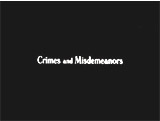
|
Crimes and Misdemeanors (1989) Woody Allen's darkest and most somber movie took a long, provocative, and ultimately downbeat look at morality with its ensemble cast. Dual stories about Manhattanites, each composing about one-half of the film, were interwoven together. The first story dealt with Judah Rosenthal (Martin Landau), a wealthy, law-abiding, successful and well-respected ophthalmologist, married to Miriam (Claire Bloom). However, an enraged and obsessed flight attendant and ex-lover Dolores Paley (Anjelica Huston), with whom he had been cheating on his wife, threatened to divulge the scandal and ruin his life. With this dilemma facing him, Judah was forced to take extreme measures - the contemplation of murder of his mistress by contacting his seldom-seen brother Jack (Jerry Orbach) with Mafia connections. In a tense, disquieting scene, Jack phoned Judah and notified him that "everything came out fine. It's over and done with, no problems. You can forget about it." Dolores was murdered (off-screen) when she came to her apartment door for a supposed flower delivery, and it was made to look like a burglary. Shocked at the reality of the contracted murder ("I think I've done a terrible thing"), guilt-ridden Judah went to the apartment of ex-mistress Dolores. He found her dead in her bedroom, staring lifelessly up at him. |
   Judah (Martin Landau) Looking Down on Dead Ex-Mistress Dolores (Anjelica Huston) |
|||||||||||||||||||||||||||||||

|
Cujo (1983) #58 This horror-thriller from director Lewis Teague was adapted from Stephen King's 1981 novel of the same name. It told about a monstrous, rampaging, rabid (from a bat bite in a cave), ferocious and snarling St. Bernard dog. The slobbering Cujo attacked hysterical mother Donna Trenton (Dee Wallace Stone) and her petrified 4 year-old son Tad (Danny Pintauro) in a locked, broken-down, sweltering, two-door Ford Pinto at Joe Cambers' (Ed Lauter) deserted farm-garage-junkyard. Cujo had already assaulted and killed Joe and his neighbor. In a shock scene, the mean-tempered dog suddenly first appeared at her broken-down, canary-yellow Pinto's passenger door, as the mother struggled to roll up the window and protect her son. The two were soon trapped in the car.
During a climactic struggle, Donna impaled the psycho dog on the sharpened broken end of a baseball bat when it leaped on top of her. She thought the dog was dead in the yard, as she went into the house. She tended to a dehydrated Tad on the kitchen table, and gave him mouth-to-mouth resuscitation. Surprisingly, the mad animal was resurrected and made a final attack upon Donna (in a slow-motion jump-scene to her amazement, Cujo burst through the kitchen window behind her into the house). There, she eventually shot Cujo to death (with the dead Sheriff's revolver) when it lept at her with its jaws open. |
  
|
|||||||||||||||||||||||||||||||

|
The Curse of Frankenstein (1957, UK) In Hammer Studio's version of the Frankenstein tale (based on the classic story by Mary W. Shelley) that was directed by Terence Fisher, the famed Universal monster Frankenstein appeared for the first time in color. This monster film starred Peter Cushing as the insane Baron Dr. Victor Frankenstein, and Christopher Lee in his first (and last) appearance as the Monster (or "Creature"). It marked the advent of a long cycle of the studio's stylistic gothic horror films, with Lee also playing the famed Dracula vampire, as in Fisher's Horror of Dracula (1958) the next year. The success of a new generation of horror films was often credited to this first film in the series, one of the most profitable films (to date) in Britain. The Hammer horror films boldly and riskily substituted a new actor for the square-shaped monster (replacing Boris Karloff), added colorful cinematography and impressive and lush art direction, and more blood, gore and sex than their predecessors. The remaining six sequels of the Hammer Frankenstein series were:
The low-budget film opened with a title screen: "More than a hundred years ago, in a mountain village in Switzerland, lived a man whose strange experiments with the dead have since become legend. The legend is still told with horror the world over...It is the legend of..." (THE CURSE OF FRANKENSTEIN - title credits) Then in 1860 Switzerland, Baron Victor von Frankenstein (Peter Cushing) was imprisoned (and awaiting execution by guillotine) - for the murder of his maid Justine (Valerie Gaunt). He was visited in his cell by a Priest (Alex Gallier), and he begged not for "spiritual comfort," but for the Priest to listen to his life story and learn of his innocence - his story was told in a flashback, beginning with: "I suppose it was when I was a boy at school. I always had a brilliant intellect....And when my mother died, I inherited the Frankenstein fortune, and this enabled me to begin the life and the work I had always planned for myself" -
|
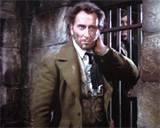 Victor Frankenstein (Peter Cushing) in His Cell - Before Flashback to His Youth 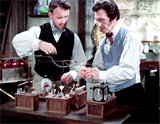 (l ro r): Tutor Paul Krempe with the Baron Victor 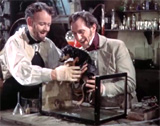 Resurrection of Dead Puppy  Victor: "We must build up our own creature"  With The Stolen Body From the Gibbet-Gallows  The Headless Corpse in a Vat  Hands of Sculptor   Victor's Fiancee Elizabeth (Hazel Court) 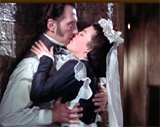 Victor's Secret Affair with Maid Justine  Victor's Obsessed Work - Examining Eyeballs  Professor Bernstein  Bernstein Pushed to His Death  Paul and Victor Fighting Over The Extracted Brain in a Glass Jar  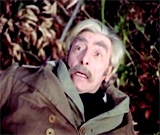 The Creature's Attack on Blind Man in Woods  Justine Blackmailing Victor: "You've got to marry me"  The Revived Creature After Brain Surgery  The Curious Elizabeth Entering the Lab  Elizabeth Spied Upon by the Creature Through Skylight 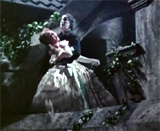 Elizabeth Grabbed by the Creature on Rooftop and Hit By Victor's Gunshot |
|||||||||||||||||||||||||||||||
(alphabetical by film title, illustrated) Intro | #s-A | B | C-1 | C-2 | D-1 | D-2 | E | F | G | H I-J | K-L | M | N-O | P | Q-R | S-1 | S-2 | S-3 | T | U-Z |